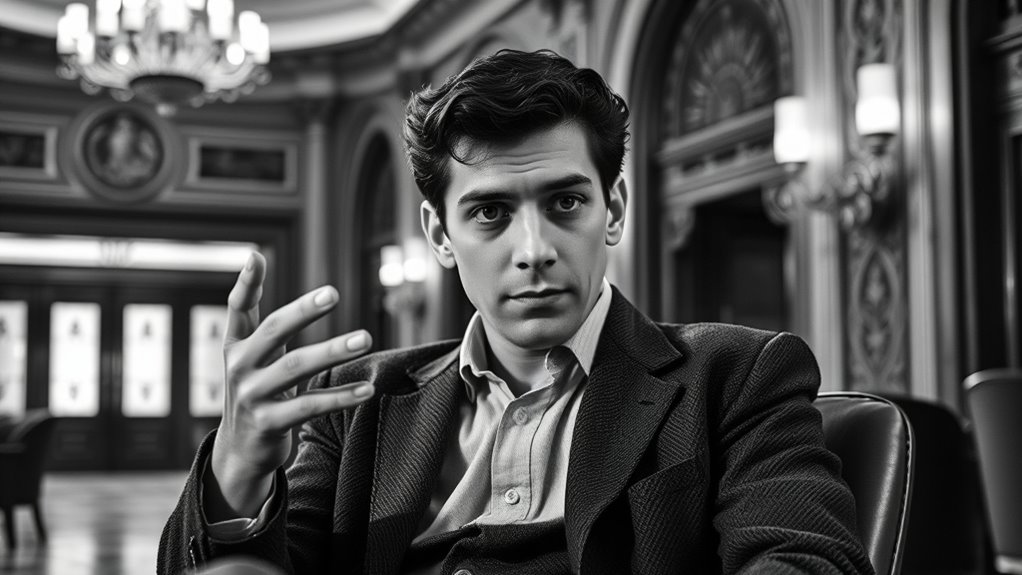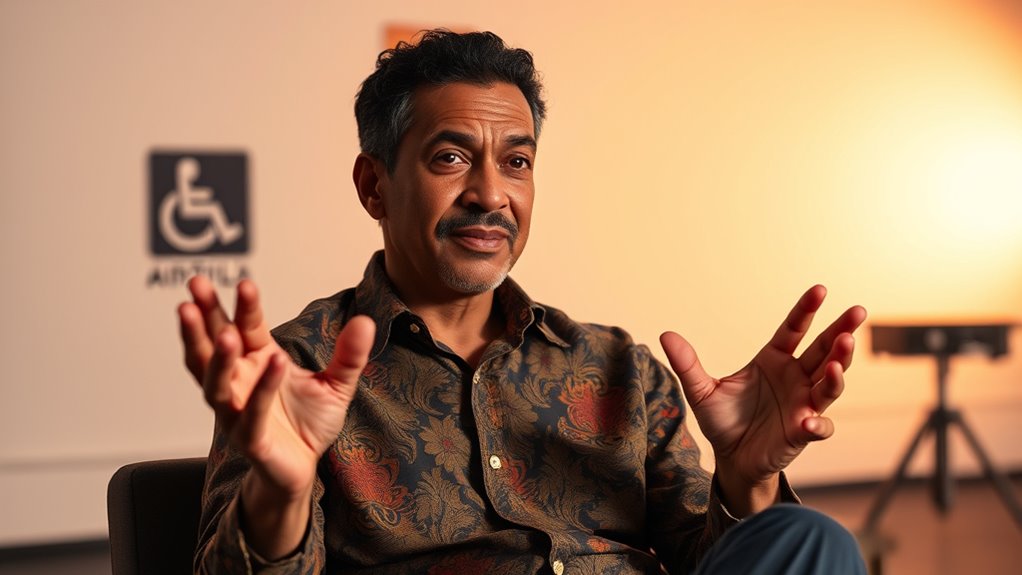Emerson Romero was a deaf actor and accessibility pioneer who transformed film for the deaf community. Despite losing hearing early in life, he developed skills in lip reading and performed in silent comedies, gaining fame. He invented innovative film captioning techniques that allowed deaf audiences to enjoy sound films fully. If you keep exploring, you’ll discover how his work shaped modern accessibility and inspired generations behind the screen.
Key Takeaways
- Emerson Romero was a deaf actor known for his silent film performances and expressive physical comedy in over 24 silent shorts.
- He founded the Theatre Guild of the Deaf in 1934, promoting deaf culture, arts, and authentic storytelling through plays and performances.
- Romero pioneered early film captioning techniques, inventing methods to add text to sound films, enhancing accessibility for deaf audiences.
- His innovations in captioning technology laid the groundwork for modern digital closed captioning systems used today.
- Recognized as a pioneer in accessibility, Romero’s work significantly expanded film and media access for deaf and hard-of-hearing communities.
Early Life and Educational Journey

Emerson Romero was born on August 19, 1900, in Havana, Cuba, and lost his hearing at age six due to illness. The illness, whooping cough, left him completely deaf during early childhood. His family moved to the United States, where he faced new challenges. You attend New York City’s Wright Oral School for the Deaf, focusing on oral education methods. There, you develop skills in lip reading and speech, gaining a foundation for communication despite your deafness. Your education prepares you for early work opportunities and helps you navigate a world designed for hearing people. This early schooling becomes a vital step toward your later success in entertainment and advocacy, shaping your resilience and determination to overcome barriers. Incorporating oral communication techniques and continuing your education further expanded your opportunities and ability to connect with others.
Silent Film Stardom and Artistic Achievements

You see how Romero’s silent film performances relied on expressive facial cues and body language, making his acting accessible despite his deafness. His stunt work and physical comedy showcased his artistic skills, helping him stand out alongside notable stars like W. C. Fields. These achievements highlight how silent cinema enabled Romero to make a lasting impact in Hollywood’s early years. Additionally, Romero’s ability to communicate through visual expressions allowed him to connect with audiences without relying on spoken dialogue, further demonstrating the power of silent film techniques. The use of headphones in modern times can enhance the viewing experience by providing clear audio, especially for those with hearing impairments or in noisy environments.
Silent Film Performances
During the 1920s silent film era, Romero made a remarkable impact with over 24 two-reel comedies, earning recognition for his expressive physical comedy and innovative acting style. Using the stage name Tommy Albert, he starred in titles like *Beachnuts*, *Great Guns*, *Sappy Days*, and *The Cat’s Meow*, showcasing his athleticism and comedic timing. Romero performed his own makeup, enhancing his screen presence, and developed a timing method synced with camera cranking, maximizing physical gestures. His comedy relied heavily on visual expressiveness, appealing to both Deaf and hearing audiences. His energetic performances broke barriers for Deaf actors, making him a pioneer of silent film stardom. His work highlighted the importance of visual storytelling in silent cinema, demonstrating how physical expression can transcend language barriers.
Artistic Stunt Skills
Romero’s remarkable athleticism and stunt skills played a crucial role in his success as a silent film star. Your physical agility allowed you to perform your own slapstick and rolling stunts, such as falling, tripping, and exaggerated collapses that defined silent comedy. You mastered precise timing to match the hand-cranking speed of early cameras, ensuring your movements synchronized perfectly with filming. Your ability to control these physical performances enhanced visual humor and safety. To highlight your skills:
- Executed complex stunts with a focus on safety and comedic effect.
- Developed the skill to memorize and match cameraman cranking motions.
- Performed physical comedy that demanded impeccable timing.
- Maintained control during stunts, amplifying visual storytelling without sound effects.
- Leveraged vetted conversion kits to understand mechanical and power aspects that could inform stunt safety and coordination.
Early Hollywood Impact
In the vibrant landscape of early Hollywood, silent films offered a unique platform for deaf actors like Emerson Romero to showcase their talents and break barriers. By relying on expressive body language and facial cues, Romero demonstrated that deaf actors could captivate audiences without sound. Acting under the name Tommy Albert, he appeared in over 20 short silent films, including “Great Guns” and “The Cat’s Meow,” earning recognition for his screen presence. Romero’s work helped normalize deaf representation, inspiring other deaf performers like Carmen de Arcos. His visual storytelling skills made him a standout in silent cinema, where deaf audiences could fully engage. Romero’s contributions marked a significant step toward inclusion, proving that deaf actors could shine in Hollywood’s early days before the rise of sound films shifted opportunities away from them. His performances challenged stereotypes and showcased the depth of talent within the deaf community, paving the way for greater acceptance in the industry.
Transition Challenges With the Advent of Sound Films

The advent of sound films in the late 1920s fundamentally reshaped the cinematic landscape, but it also created significant challenges for deaf audiences and actors. You find that silent films relied on visual storytelling and intertitles, which deaf viewers could fully access. With the rise of “talkies,” dialogue became central, marginalizing those who couldn’t hear. This shift led to several issues:
- Intertitles were phased out, reducing visual aids for comprehension.
- Theater headphones for hard-of-hearing viewers proved largely ineffective for deaf audiences.
- Lip-reading became less reliable, especially when actors didn’t face the camera.
- The focus on speech pushed out silent acting styles, making it harder for deaf actors to adapt.
One significant change was the decline of accessible communication methods like intertitles, which had been crucial for deaf viewers. This progression diminished accessibility, leaving deaf audiences and actors at a disadvantage. Additionally, the lack of accessible communication methods contributed to social isolation for deaf individuals within the cinematic experience.
Stage Work and Advocacy for the Deaf Community

Emerson Romero’s founding of the Theatre Guild of the Deaf in 1934 marked a significant milestone in advocating for deaf performers and audiences. You recognize how this theatre, created with John Funk and Sam Block, aimed to serve as a social hub and entertainment venue specifically for the deaf community. It focused on producing plays starring deaf actors, increasing visibility, and providing more employment opportunities. Romero actively participated as an actor and director, mentoring deaf talent and shaping authentic storytelling. His work helped foster a strong sense of community, blending theatre with social engagement. By showcasing deaf culture through performances and community events, Romero elevated deaf arts and created a lasting platform for expression and empowerment during a time of widespread marginalization. The theatre also provided a space for deaf individuals to develop their artistic skills and gain confidence in their cultural identity.
Innovations in Film Captioning and Accessibility

Innovations in film captioning and accessibility have transformed how deaf and hard-of-hearing audiences experience movies. You benefit from advanced techniques that make films more inclusive. Early captioning involved physically cutting and splicing film reels to insert text, a labor-intensive process. Over time, the technology evolved with:
- Mechanical methods that used scissors, glue, and precise placement.
- Captions positioned at the bottom of the screen, synchronized with dialogue.
- Efforts to overcome industry resistance due to concerns about distraction.
- Romero’s pioneering techniques that laid the foundation for modern closed captioning. His innovations demonstrated the importance of visual communication in film accessibility, inspiring future technological developments. These innovations enabled broader access, influenced institutions, and inspired standards adopted worldwide. The development of digital captioning has further improved the clarity and timing of captions, making content more accessible and enjoyable for viewers. Today, streaming platforms and digital media continue Romero’s legacy, making media more accessible for all audiences.
Personal Life, Heritage, and Later Years

Born on August 19, 1900, in Havana, Cuba, Emerson Romero grew up immersed in a family with strong artistic roots, blending Cuban heritage with American culture after moving to the United States. Deafened at age six by whooping cough, you face communication challenges early on but overcome them through education at the Wright Oral School in New York City, focusing on speech and lip-reading. Your connection to Hollywood runs through your cousin, Cesar Romero, linking you to a notable entertainment lineage. Later in life, you develop groundbreaking captioning techniques for films, advocating for accessibility and inclusion. Despite limited commercial success, your contributions leave a lasting legacy in both art and disability rights. Throughout his lifetime, you actively worked to improve communication access for the deaf community through innovative methods and advocacy, including the integration of emerging AI Accessibility technologies. You pass away in Boulder, Colorado, in 1972, remembered as a pioneer who bridged cultures, art, and advocacy.
Lasting Impact and Recognition in Film and Accessibility

Have you ever wondered how modern film accessibility owes much to the pioneering work of a deaf actor who challenged technological and societal barriers? Romero’s innovations in captioning and assistive devices transformed accessibility. His efforts:
- Developed the first known technique for captioning sound films, enabling deaf audiences to follow dialogue and sound cues. This captioning technology laid the groundwork for digital captioning systems used today.
- Inspired government programs like Captioned Films for the Deaf, broadening access despite initial technical limitations.
- Laid the groundwork for today’s widespread closed captioning systems used in TV and movies.
- Created assistive devices like vibrating alarms and smoke detectors, extending his advocacy beyond film.
- His pioneering captioning methods, such as splicing film strips to add text, laid the foundation for modern digital captioning techniques.
Recognized with civic awards and commemorated by a Google Doodle in 2024, Romero’s legacy endures as a cornerstone of accessibility and cultural progress.
Frequently Asked Questions
How Did Romero Develop His Captioning Technique for Sound Films?
You might wonder how Romero developed his captioning technique for sound films. He recognized the lack of accessible media for deaf audiences and took action by physically altering film reels in 1947. Using hand-editing tools, he manually cut and inserted caption frames between dialogue scenes on the original film stock. This labor-intensive process was innovative at the time and laid the groundwork for modern captioning technology.
What Specific Challenges Did Romero Face as a Deaf Actor in Hollywood?
Facing fierce friction and fading opportunities, you struggle as a deaf actor in Hollywood’s shifting scene. The silent struggle includes social separation, sidelining in spotlighting roles, and the industry’s indifference to accessibility needs. You confront communication challenges, cultural exclusion, and career collapse, all fueled by a lack of understanding and support. Despite these hurdles, you pioneer progress, pushing for accessibility and opening doors for future deaf performers to flourish in film.
How Did Romero’s Work Influence Modern Film Accessibility Standards?
You see how Romero’s innovations shaped modern film accessibility standards by pioneering open captions, making films more inclusive for deaf audiences. His DIY methods inspired current captioning technologies, like digital subtitles and AI-generated captions, that are now widely used. His advocacy helped establish legal requirements for captioning in TV and streaming, ensuring accessible entertainment for all. Romero’s legacy continues to influence ongoing efforts toward universal media accessibility.
What Was Romero’s Relationship With Cesar Romero and Other Hollywood Figures?
They say “family is everything,” and in Hollywood, your connections shape your story. You learn that Emerson Romero was César Romero’s first cousin, sharing Cuban roots and Hollywood ties. While they moved in different circles, Emerson’s work championed deaf actors and accessibility, influencing others behind the scenes. César’s long-lasting career highlighted Latino talent. Together, they left a legacy rooted in cultural pride and breaking barriers, even if their paths rarely crossed professionally.
Are There Surviving Examples of Romero’S Silent Films or Captioning Experiments?
You’d find that only a few of Romero’s silent films still exist today, mainly short comedies from the 1920s, like *Beachnuts* and *The Cat’s Meow*. Most of his works are considered lost. However, some surviving footage, along with photographs and records, helps you see his contributions. His captioning experiments, though rudimentary, were groundbreaking, laying groundwork for modern closed captioning technologies used to make media accessible today.
Conclusion
Emerson Romero’s journey is a beacon guiding us through a silent world into one of understanding and inclusion. His legacy, like a lighthouse shining through fog, illuminates the path toward true accessibility. You carry his spirit in championing voices unheard and barriers broken. As his story echoes in every caption and gesture, remember: each act of awareness brightens the future, transforming silence into a symphony of connection that endures beyond time.










